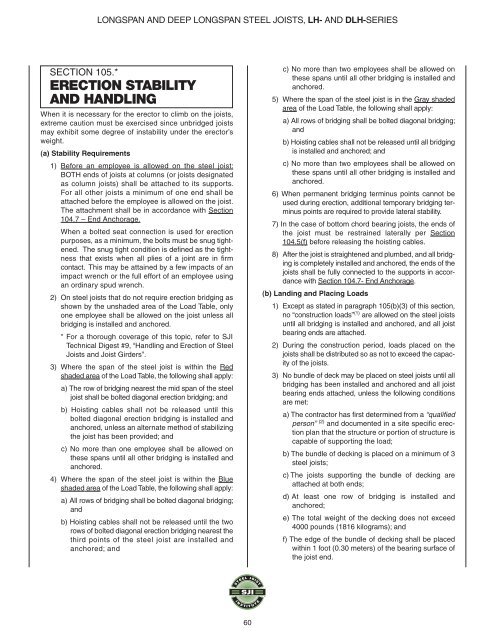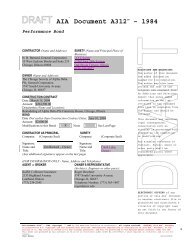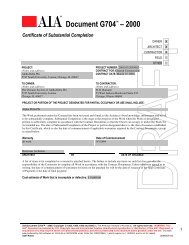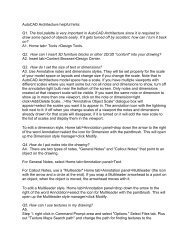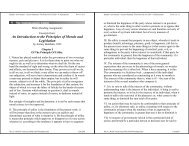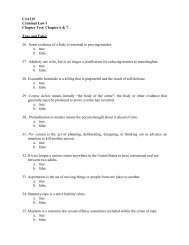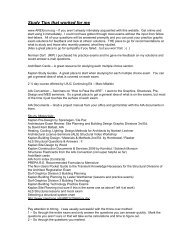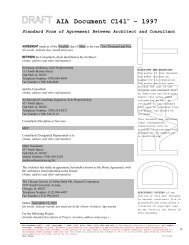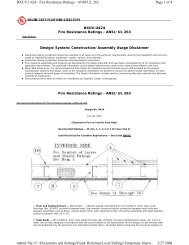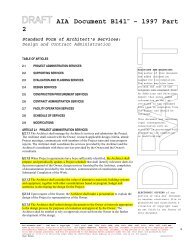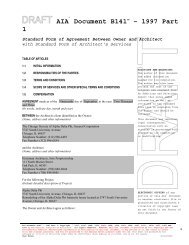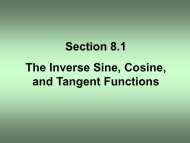Steel Joist Manual
Steel Joist Manual
Steel Joist Manual
You also want an ePaper? Increase the reach of your titles
YUMPU automatically turns print PDFs into web optimized ePapers that Google loves.
LONGSPAN AND DEEP LONGSPAN STEEL JOISTS, LH- AND DLH-SERIES<br />
SECTION 105.*<br />
ERECTION STABILITY<br />
AND HANDLING<br />
When it is necessary for the erector to climb on the joists,<br />
extreme caution must be exercised since unbridged joists<br />
may exhibit some degree of instability under the erector’s<br />
weight.<br />
(a) Stability Requirements<br />
1) Before an employee is allowed on the steel joist:<br />
BOTH ends of joists at columns (or joists designated<br />
as column joists) shall be attached to its supports.<br />
For all other joists a minimum of one end shall be<br />
attached before the employee is allowed on the joist.<br />
The attachment shall be in accordance with Section<br />
104.7 – End Anchorage.<br />
When a bolted seat connection is used for erection<br />
purposes, as a minimum, the bolts must be snug tightened.<br />
The snug tight condition is defined as the tightness<br />
that exists when all plies of a joint are in firm<br />
contact. This may be attained by a few impacts of an<br />
impact wrench or the full effort of an employee using<br />
an ordinary spud wrench.<br />
2) On steel joists that do not require erection bridging as<br />
shown by the unshaded area of the Load Table, only<br />
one employee shall be allowed on the joist unless all<br />
bridging is installed and anchored.<br />
* For a thorough coverage of this topic, refer to SJI<br />
Technical Digest #9, “Handling and Erection of <strong>Steel</strong><br />
<strong>Joist</strong>s and <strong>Joist</strong> Girders”.<br />
3) Where the span of the steel joist is within the Red<br />
shaded area of the Load Table, the following shall apply:<br />
a) The row of bridging nearest the mid span of the steel<br />
joist shall be bolted diagonal erection bridging; and<br />
b) Hoisting cables shall not be released until this<br />
bolted diagonal erection bridging is installed and<br />
anchored, unless an alternate method of stabilizing<br />
the joist has been provided; and<br />
c) No more than one employee shall be allowed on<br />
these spans until all other bridging is installed and<br />
anchored.<br />
4) Where the span of the steel joist is within the Blue<br />
shaded area of the Load Table, the following shall apply:<br />
a) All rows of bridging shall be bolted diagonal bridging;<br />
and<br />
b) Hoisting cables shall not be released until the two<br />
rows of bolted diagonal erection bridging nearest the<br />
third points of the steel joist are installed and<br />
anchored; and<br />
c) No more than two employees shall be allowed on<br />
these spans until all other bridging is installed and<br />
anchored.<br />
5) Where the span of the steel joist is in the Gray shaded<br />
area of the Load Table, the following shall apply:<br />
a) All rows of bridging shall be bolted diagonal bridging;<br />
and<br />
b) Hoisting cables shall not be released until all bridging<br />
is installed and anchored; and<br />
c) No more than two employees shall be allowed on<br />
these spans until all other bridging is installed and<br />
anchored.<br />
6) When permanent bridging terminus points cannot be<br />
used during erection, additional temporary bridging terminus<br />
points are required to provide lateral stability.<br />
7) In the case of bottom chord bearing joists, the ends of<br />
the joist must be restrained laterally per Section<br />
104.5(f) before releasing the hoisting cables.<br />
8) After the joist is straightened and plumbed, and all bridging<br />
is completely installed and anchored, the ends of the<br />
joists shall be fully connected to the supports in accordance<br />
with Section 104.7- End Anchorage.<br />
(b) Landing and Placing Loads<br />
1) Except as stated in paragraph 105(b)(3) of this section,<br />
no “construction loads” (1) are allowed on the steel joists<br />
until all bridging is installed and anchored, and all joist<br />
bearing ends are attached.<br />
2) During the construction period, loads placed on the<br />
joists shall be distributed so as not to exceed the capacity<br />
of the joists.<br />
3) No bundle of deck may be placed on steel joists until all<br />
bridging has been installed and anchored and all joist<br />
bearing ends attached, unless the following conditions<br />
are met:<br />
a) The contractor has first determined from a “qualified<br />
person” (2) and documented in a site specific erection<br />
plan that the structure or portion of structure is<br />
capable of supporting the load;<br />
b) The bundle of decking is placed on a minimum of 3<br />
steel joists;<br />
c) The joists supporting the bundle of decking are<br />
attached at both ends;<br />
d) At least one row of bridging is installed and<br />
anchored;<br />
e) The total weight of the decking does not exceed<br />
4000 pounds (1816 kilograms); and<br />
f) The edge of the bundle of decking shall be placed<br />
within 1 foot (0.30 meters) of the bearing surface of<br />
the joist end.<br />
60


